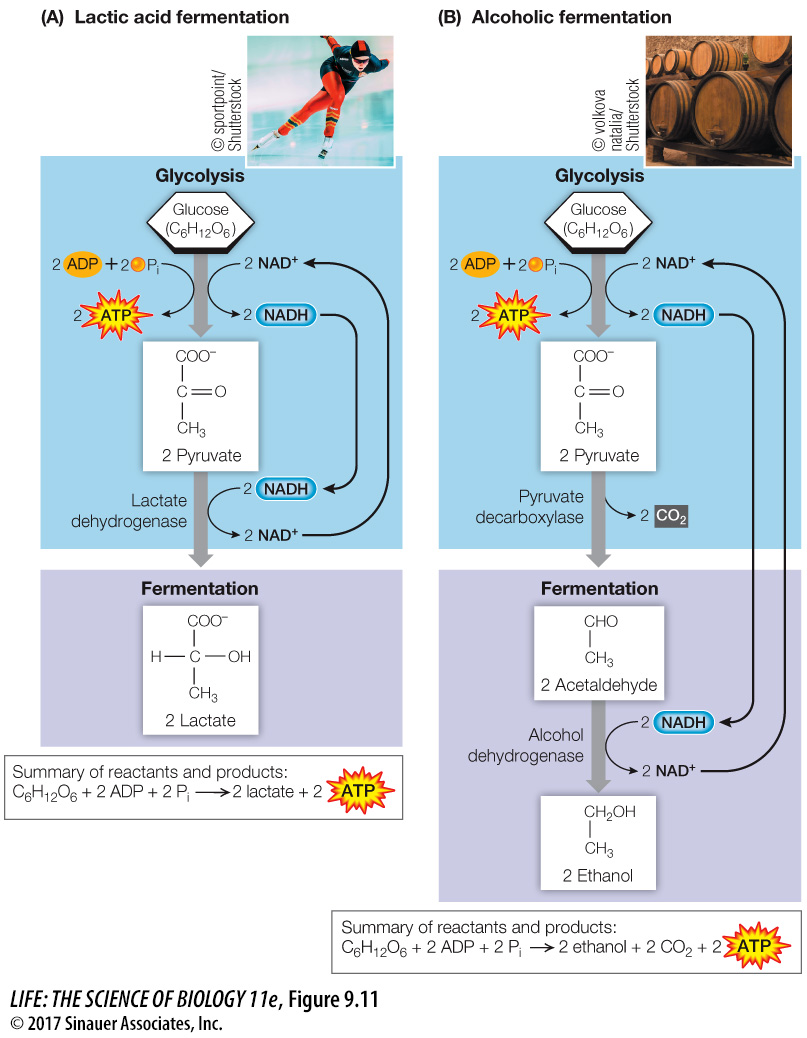key concept
9.4
In the Absence of Oxygen, Some Energy Is Harvested from Glucose
key concept
9.4
In the Absence of Oxygen, Some Energy Is Harvested from Glucose
In eukaryotes, in the absence of O2 (anaerobic conditions), a small amount of ATP can be produced by glycolysis and fermentation. Like glycolysis, fermentation pathways occur in the cytoplasm. There are many different types of fermentation, but they all operate to regenerate NAD+ so that the NAD+-requiring reactions of glycolysis can continue. The two best-
Lactic acid fermentation, the end product of which is lactic acid (lactate)
Alcoholic fermentation, the end product of which is ethyl alcohol (ethanol)
focus your learning
Lactic acid fermentation and alcoholic fermentation are pathways that allow glucose to be oxidized in the absence of oxygen by regenerating oxidized electron carriers.
In lactic acid fermentation, pyruvate serves as the electron acceptor and lactate is the product (Figure 9.11A). This process takes place in many microorganisms and complex organisms, including higher plants and vertebrates. A notable example of lactic acid fermentation occurs in vertebrate muscle tissue. Usually, vertebrates get their energy for muscle contraction aerobically, with the circulatory system supplying O2 to muscles. In small vertebrates, this is almost always adequate: for example, birds can fly long distances without resting. But in larger vertebrates such as humans, the circulatory system is not up to the task of delivering enough O2 when the need is great, such as during intense activity. At this point, the muscle cells break down glycogen (a stored polysaccharide; see Figure 3.18) and undergo lactic acid fermentation.

Lactate buildup becomes a problem after prolonged periods of intense exercise because it is associated with an increase in the H+ concentration in the cell, lowering the pH. This affects cellular activities, which return to normal upon resting. Lactate dehydrogenase, the enzyme that catalyzes the fermentation reaction, works in both directions. That is, when O2 is available it can catalyze the oxidation of lactate to form pyruvate, which is then catabolized to CO2 with concomitant energy release to form ATP. When lactate levels are decreased, muscle activity can resume.
Alcoholic fermentation takes place in certain yeasts (eukaryotic microbes) and some plant cells under anaerobic conditions. This process requires two enzymes, pyruvate decarboxylase and alcohol dehydrogenase, which metabolize pyruvate to ethanol (Figure 9.11B). As with lactic acid fermentation, the reactions are essentially reversible. For thousands of years, humans have used anaerobic fermentation by yeast cells to produce alcoholic beverages. The cells use sugars from plant sources (glucose from grapes or maltose from barley) to produce the end product, ethanol, in wine and beer.
By recycling NAD+, fermentation allows glycolysis to continue, thus producing small amounts of ATP through substrate-